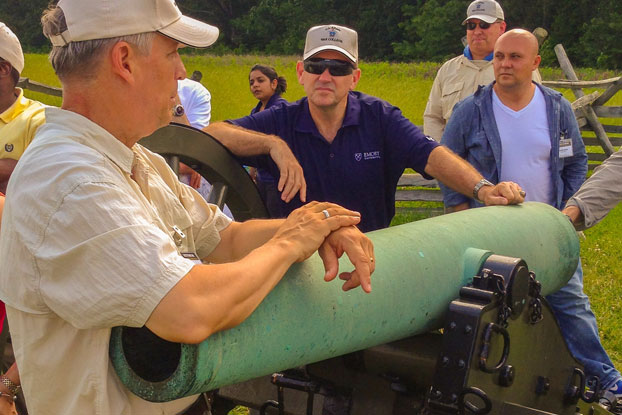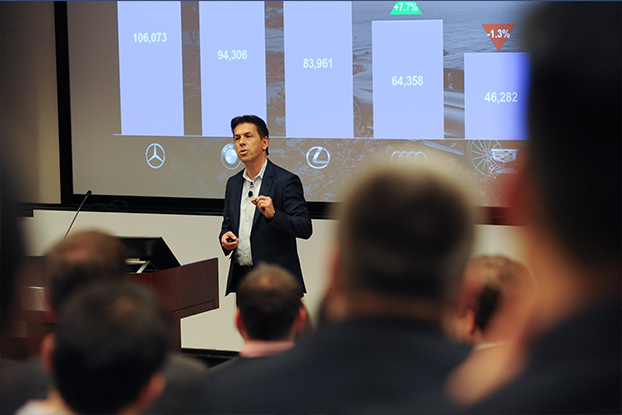EDITOR’S NOTE: The Gettysburg Leadership Experience program brings together premiere U.S. Army War College faculty, historians, and Goizueta Business School staff/faculty to educate a selected group of Goizueta MBA candidates, alumni, staff, and faculty for a unique leadership development experience. The two day seminar is designed for the MBA candidates, alumni, staff, and faculty to discuss the intricacies of strategic leadership, critical thinking, personality in command and resourcing issues providing direct applicability to the dilemmas facing senior executives today. Jon Keen is an MBA alumnus.
Recently I had the great pleasure of participating in a full day tour of the Gettysburg battlefield, along with 17 other Goizueta faculty, staff, students, and alumni. The tour was part of a leadership program conducted in partnership with the Army War College, located in Carlisle, Penn., and was designed to impart leadership lessons through the history of Civil War events and leaders.
Our guide for the battlefield tour was retired colonel and current Army War College faculty member, Dr. Paul Jussel. His knowledge of military history — the events, people, personalities, relationships, and much more — was truly amazing. Paul guided us chronologically through the battle and leadership decisions, stopping and walking through the fields and up the hills discussing critical decision points from the approximately three-day battle. We discussed how these decision points and leadership styles relate to our own experiences and challenges. In addition, we started and ended the program with group discussions facilitated by Goizueta and Army War College faculty and staff, discussing the key leadership lessons we learned from our preparation and from the battlefield tour.
In all I captured about 20 lessons through this great experience; lessons that will influence how I lead and the decisions that I make. If you ever get the chance to participate in similar leadership program, I recommend it.
However, my top five lessons are below if you missed this opportunity.
These lessons are not one-line solutions to your leadership problems. They are challenging questions that you have or will face as a senior leader, therefore are worth spending time thinking about.
How do you deal with information that doesn’t fit the pattern?
Harry Heth was a Division commander in the Confederate Army of Northern Virginia. On July 1 a Brigade Commander from North Carolina, new to the Division, spotted soldiers wearing blue coats in the small town of Gettysburg, Penn. At that time, the Confederate Army had little awareness of the Union Army of the Potomac’s position. Heth and A.P. Hill, his Corps Commander, did not believe this new Brigade Commander’s warnings. They assumed these soldiers were just militia since that is what had been reported in the area and surely they would know if the Army of the Potomac was that close. Their bias resulted in the unintentional commitment of forces and start of the Battle of Gettysburg.
When do you as a leader need to be at the point of crisis?
John Reynolds was one of the Union Army’s most respected general officers. He was commanding the “left wing” of the Army of the Potomac at the start of the Battle of Gettysburg, overseeing three corps and a division of cavalry. After his cavalry held out against Confederate attacks, waiting for the infantry to arrive, Reynolds rode forward to help get the infantry into position. He knew this was a critical point in maintaining valued ground and initiative. However, soon after giving the command “forward men” he was shot in the neck and died. His loss was felt by his men and through the subsequent resulting events. However, his presence and timely coordination was also critical. It was a delicate balance between short-term and long-term personal risk and mission accomplishment.
Whose responsibility is it to change styles given leadership and management differences?
Robert E. Lee is one of the most respected generals in our nation’s history. However, at Gettysburg, miscommunication between him and new, subordinate leaders caused problems for the Army of Northern Virginia. Shortly before Gettysburg, Lee had to reorganize his Army because one of his most trusted leaders, Stonewall Jackson, was killed at the Battle of Chancellorsville. After the reorganization, leaders like Richard Ewell reported directly to Lee. Under Jackson, Ewell had been highly successful. However, he was known as needing precise instructions to operate effectively, while Lee was known to give significant discretion to his battlefield commanders. At a critical point on the first day of the battle Lee told Ewell to take Cemetery Hill “if practicable.” Ewell did not react well to this order and ultimately did not take the Hill. This difference may have cost them the battle.
As a senior leader, what do you do when a subordinate makes a significant error?
George Meade was appointed leader of the Army of the Potomac three days before the Battle of Gettysburg and was not Lincoln’s first choice. However, he is hailed for his successful leadership and use of subordinates at the battle; although one subordinate, Daniel Sickles, caused him major problems. On the second day of the battle, Sickles ignored Meade’s order to place his corps in the defensive line, choosing to place units farther forward. When Meade recognized the error he rode to meet with Sickles at the line. Sickles relented, but it was too late. Meade saw the Confederates advancing on Sickles flank putting the entire corps at risk. Instead of leaving Sickles to solve his own problem, Meade said “you got us in this situation and it is my job to get us out.”
How do you raise people’s spirit to get them to accomplish unbelievable things?
The fight for Cemetery Ridge was another pivotal moment on the second day of the battle. The Union Army was delayed in reinforcing the ridge and the commander, Winfield Scott, Hancock needed more time. Defending that terrain was the 1st Minnesota Volunteer Infantry. Hancock asked 1st Minnesota to charge into a situation where they would be out-manned at least 5 to 1; Colonel Colvill was their commander. Dedicated to their purpose and realizing the importance of the situation, Colvill ordered the charge without hesitation. Of the 282 Minnesotans who made the charge 217 were killed or wounded, including Colvill who was hit three times and survived. They successfully slowed the Confederate advance allowing more Union regiments to arrive.
These lessons from the events and leaders of Gettysburg resonate today as much as in 1863. During our discussions after the tour, Goizueta faculty, staff, and students described situations from their own lives where these lessons applied.
Where do they apply in yours?











